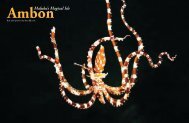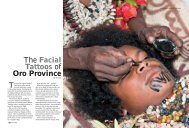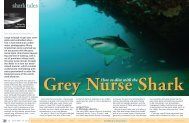Rapid Ecological Assessment - Indo-Pacific Images
Rapid Ecological Assessment - Indo-Pacific Images
Rapid Ecological Assessment - Indo-Pacific Images
- No tags were found...
You also want an ePaper? Increase the reach of your titles
YUMPU automatically turns print PDFs into web optimized ePapers that Google loves.
Chapter 1 – Executive Summary<br />
recruitment in the form of numerous established young coral colonies. This high survival may be attributable<br />
to the cooling of heated water by current-induced vertical mixing with deeper cooler water, protection of<br />
some communities from damage by sunlight through high island shading, and stress hardening for those<br />
shallow coral communities exposed during low tides.<br />
1.3.4 Status of Sea Turtle Populations<br />
This component of the REA identified two areas that host major sea turtle rookeries. The small beaches and<br />
coves of the south Misool island chain contain nesting areas for, primarily, Hawksbill turtles (Eretmochelys<br />
imbricata). The scattered nature of this nesting habitat provides this species with some protection against the<br />
typically large subsistence egg harvest and commercial exploitation of the turtle shell. Beaches located on<br />
islands contained the highest frequency of nesting evidence. Nesting abundance on mainland Misool beaches<br />
was not so prominent. This is thought to be due to proximity of human populations, the frequency of use by<br />
transiting fishermen and the occurrence of wild boar that are known to predate eggs from nests.<br />
The islands of Sayang and Piai in northwest Waigeo contain large and concentrated rookeries of Green<br />
turtles (Chelonia mydas). The timing and magnitude of nesting on these islands is well known to local<br />
villages and to commercial turtle poachers. The islands are remote from populated islands and this allows<br />
turtle poachers greater ease to carry out their trade. Amid the hundreds of Green turtle nesting depressions<br />
lay the evidence of egg collectors and the carapaces of 68 Green turtles. Additional to this subsistence<br />
mortality, there is anecdotal evidence from villagers claiming that boats from outside of Raja Ampat visit the<br />
area to capture Green turtles for the Bali market.<br />
The archipelago is not known to contain nesting habitat for Leatherback turtles (Dermochelys coriacea).<br />
However, there are seasonal sightings of this species by villagers in the straits that separate the main islands.<br />
As there is a large Leatherback rookery on the north coast of the Birdshead Peninsular, it is thought that Raja<br />
Ampat is a major migration route for Papuan Leatherbacks.<br />
1.3.5 Coastal Botanical Survey<br />
The botanical component of the REA categorised eight principal communities (mangroves, swamp forest,<br />
beach forest. lowland forest on deep mineralized soil, secondary forests, savanna, lowland forest on<br />
limestone karst, and lowland ultrabasic scrub and forest).<br />
Raja Ampat mangroves are markedly depauperate except in a few places where estuarine flats and tidal<br />
rivers have provided ample habitat for the Bruguiera-Rhizophora associations. Among investigated sites, the<br />
best examples of this community were seen on Misool, along the lower Gam and Kasim rivers. At the second<br />
locality, there is a well-developed upstream sequence of mangrove succession. However in most parts of the<br />
archipelago, mangroves are sparingly represented.<br />
Sago forests are scattered through the Raja Ampat islands, wherever inundated soils are present. Although<br />
floristic diversity is very low, the sago association is of considerable subsistence value as a source of dietary<br />
starch obtained from the pith. Beach forests are mostly composed of widely distributed or pantropical taxa,<br />
but have been reduced over much of their former range because of anthropogenic pressures. A good example<br />
of typical beach forest is present at north Kofiau. On uninhabited Sayang Island, a different sort of<br />
beachfront association was recorded on sandy flats.<br />
Lowland forest was found on deep mineralized soil near Kapatlap on Salawati, and on the north and south<br />
shores of Batanta. This was probably the most species-rich environment from the survey. In western Raja<br />
Ampat, deep soil habitats are generally absent except in the flood plain of large rivers, or in the ravines on<br />
limestone karst. Such areas have tall forests comparable to the Batanta/Salawati formations, but are speciespoor<br />
and of limited size.<br />
16





